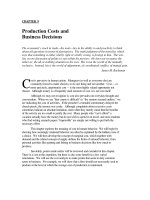Chapter 9: EC Strategy and Implementation Plan docx
Bạn đang xem bản rút gọn của tài liệu. Xem và tải ngay bản đầy đủ của tài liệu tại đây (208.46 KB, 39 trang )
1
© Prentice Hall, 2000
Chapter 9
EC Strategy and
Implementation Plan
2
© Prentice Hall, 2000
Learning Objectives
Describe what a business strategy and
implementation plan are
Understand the process of formulating EC
strategies
Explain the issues involved in EC implementation
planning
Experience the role of intelligent agents in the
strategic perspective
Characterize how the strategic planning evolves
throughout the business cycle
Describe the key management issues in the
strategic planning
3
© Prentice Hall, 2000
IBM’s E-Business’s Strategy
Following four goals:
To lead IBM’s strategy to transform itself into e-
business and to act as a catalyst to help facilitate that
transformation.
To help out business units become more effective in
their use of the Internet/intranet, both internally and
with their customers.
To establish a strategy for the corporate Internet site.
This would include a definition of how it should look,
‘feel’ and be navigated. In short, to create an online
environment most conducive to customers doing
business with IBM.
To leverage the wealth of e-business transformational
case studies there are within IBM to highlight the
potential of e-business to IBM’s customers.
4
© Prentice Hall, 2000
IBM focused on key initiatives:
IBM’s E-Business’s Strategy (cont.)
e-commerce— selling more goods via the Web
e-care for customers— providing all kinds of customer support
on-line
e-care for business partners— dedicated services providing
faster, better information for these important groups
e-care for employees— improving the effectiveness of IBMers by
making the right information and services available to them
e-procurement— working closely with IBM’s customers and
suppliers to improve the tendering process and to better
administer the huge number of transactions involved
e-marketing communications— using the Internet to better
communicate IBM’s marketing stance
5
© Prentice Hall, 2000
Strategic Planning for EC
Industry and
competitive
analysis
Strategy
formulation
Strategy
reassessment
Implement-ation
plan
6
© Prentice Hall, 2000
Industry and Competitive Analysis
Monitoring, evaluating, disseminating of
information from the external and internal
environments
SWOT Analysis
Strengths
Weaknesses
Opportunities
Threats
7
© Prentice Hall, 2000
Strengths (S) Weaknesses (W)
Opportunities (O)
Threats (T)
INTERNAL
FACTORS
EXTERNAL
FACTORS
SO Strategies
Generate strategies
here that use
strengths to take
advantages of
opportunities
WO Strategies
Generate strategies
here that take
advantage of
opportunities by
overcome weaknesses
ST Strategies
Generate strategies
here that use
strengths to avoid
threats
WT Strategies
Generate strategies
here that minimize
weaknesses and avoid
threats
Industry and Competitive Analysis (cont.)
8
© Prentice Hall, 2000
Strategy Formulation
Strategy formulation
Development of long-range plans
Organization’s mission
Purpose or reason for the organization’s existence
3 main reasons for establishing Web site
MARKETING, CUSTOMER SUPPORT, and SALES
Products with good fit for EC
Shipped easily or transmitted electronically
Targets knowledgeable buyers
Price falls within certain optimum ranges
9
© Prentice Hall, 2000
EC Critical Success Factors
Special products or services traded
Top management support
Project team reflecting various functional areas
Technical infrastructure
Customer acceptance
User friendly Web interface
Integration with the corporate legacy systems
Security and control of the EC system
Competition and market situation
Pilot project and corporate knowledge
Promotion and internal communication
Cost of the EC project
Level of trust between buyers and sellers
10
© Prentice Hall, 2000
A Value Analysis Approach
Value chain
a series of activities a company performs to
achieve its goal(s)
Value added
contributes to profit and enhances the asset value
as well as the competitive position of the company
in the market
to create additional value using EC channels, a
company should consider the competitive market
and rivalry in order to best leverage its EC assets
EC Critical Success Factors (cont.)
11
© Prentice Hall, 2000
Value Analysis Questions
EC Critical Success Factors (cont.)
Representative Questions for Clarifying Value Chain
Statements
Can I realize significant margins by consolidating parts
of the value chain to my customers?
Can I create significant value for customers by reducing
the number of entities they have to deal with in the value
chain?
Representative Question for Creating New Values
Can I offer additional information of transaction service
to my existing customer base?
Can I use my ability to attract customers to generate
new sources of revenue, such as advertising or sales of
complementary products?
12
© Prentice Hall, 2000
EC Critical Success Factors (cont.)
Gartner’s Model of Customer Interaction
Customers
Extension
Customers
Retention
Customers
Selection
Customers
Acquisition
Relationship
Marketing
“What criteria
determine who will be
our most profitable
customers?”
“How can we acquire
this customer in the
most efficient and
effective way?
“How can we keep this
customer for as long as
possible?”
“How can we increase
the loyalty and the
profitability of this
customer?”
13
© Prentice Hall, 2000
Return on Investment and Risk Analysis
EC Critical Success Factors (cont.)
A ratio of resources required and benefits
generated by an EC project
Includes both quantifiable items (cost of
resources, computed monetary savings) and non
quantifiable items
Some intangible benefits
effective marketing channel
increased sales
improved customer service
14
© Prentice Hall, 2000
Return on Investment and Risk Analysis
EC Critical Success Factors (cont.)
Classified generic IT values and risks falls into the
following five categories
Values
•
Financial values— measurable to some degree
•
Strategic values— competitive advantage in the market and
benefits generated by business procedures
•
Stakeholder values— reflections of organizational redesign,
organizational learning, empowerment, information technology
architecture of a company, etc.
Risks
•
Competitive strategy risk— external, due to joint venture,
alliances, or demographic changes among others
•
Organizational risk and uncertainty— internal to company
15
© Prentice Hall, 2000
Electronic Commerce Scenarios
Open, Global Commerce Scenario
IT Events : Internet standards,new
media, proprietary solutions marginalized,
intranets, highly distributed, fat-client
architectures prevail
Business Events : Global trade, logistics on
the Internet, pay bills electronically, digital
cash widely used, smart cards, and fewer
wholesaler/salespeople
Members-Only Subnets Scenario
IT Events : Standards vary between
industries, objective measures of Internet
security, EDI standards widely adopted
Business Events : High-performance
information networks, cumbersome global
EC
Electronic Middlemen Scenario
IT Events : Transaction processing and
interface, distributor drive EC, EC activity
expands rapidly, and transaction security
deeply embedded
Business Events : One-stop shopping
popular, professional services popular with
smaller enterprises
New Consumer Marketing Channels
Scenario
IT Events : Activity oriented to consumers,
price of wireless drops, and growth of
networked multimedia
Business Events : Online transactions seen
as less convenient, security not widely
trusted, basic international norms accepted,
and wireless links increase sales productivity
© Prentice Hall, 2000
16
© Prentice Hall, 2000
Competitive Strategy
Offensive strategy— usually takes place in an
established competitor’s market
Frontal Assault— attacker must have superior resources
and willingness to persevere
Flanking Maneuver— attack a part of the market where
the competitor is weak
Bypass Attack— cut the market out from under an
established defender by offering a new type of product that
makes the competitor’s product unnecessary
Encirclement— greater product variety and/or serves
more markets
Guerrilla Warfare— use of small, intermittent assaults on
different market segments held by the competitor
17
© Prentice Hall, 2000
Defensive strategies— takes place in the
firm’s own current market position as a
defense against possible attack by a rival
Lower the probability of attack
Divert attacks to less threatening avenues
Lessen the intensity of an attack
Make competitive advantage more
sustainable
Competitive Strategy (cont.)
18
© Prentice Hall, 2000
Cooperative Strategies
Collusion— active cooperation of firms within an industry to
reduce output and increase prices in order to get around the
normal economic law of supply and demand (illegal)
Strategic Alliance— partnership of two or more
corporations or business units to achieve strategically
significant objectives that are mutually beneficial
Joint Venture— a way to temporarily combine the different
strengths of partners to achieve an outcome of value to both
Value-Chain Partnership— a strong and close alliance
in which one company or unit forms a long-term arrangement
with a key supplier or distributor for mutual advantage
19
© Prentice Hall, 2000
EC Strategy in Action
What questions should a strategic plan answer?
How is Electronic Commerce going to change our business?
How do we uncover new types of business opportunities?
How can we take advantage of new electronic linkages with
customers and trading partners?
Will intermediaries be eliminated in the process? Or do we become
intermediaries ourselves?
How do we bring more buyers together electronically (and keep
them there)?
How do we change the nature of our products and services?
Why is the Internet affecting other companies more than ours?
How do we manage and measure the evolution of our strategy?
20
© Prentice Hall, 2000
The steps to Successful EC Programs
EC Strategy in Action (cont.)
Conduct necessary education training
Review current distribution and supply chain models
Understand what your customers and partners expect from
the Web
Reevaluate the nature of your products and services
Give a new role to your human resources department
Extend your current systems to the outside
Track new competitors and market shares
Develop a Web-centric marketing strategy
Participate in the creation and development of virtual
marketplaces
Install electronic commerce management style
21
© Prentice Hall, 2000
Competitive Intelligence on the Internet
Review competitor’s Web sites
Analyze related newsgroups
Examining publicly available financial
documents
You can give prizes
Use an information delivery service
Use research companies
Solicit opinions in a chat room
22
© Prentice Hall, 2000
Using Push Technology for Competitive
Intelligence
Competitive Intelligence on the Internet (cont.)
Allow users to request updates of topics and have
the latest records automatically delivered to users’
e-mail address
Provide corporate snoopers with lots of information,
save search time and monitoring time
Several ways push models can provide competitive
intelligence information:
broadcast model
selective pull model
distributed push pull model
interactive push model
23
© Prentice Hall, 2000
Implementation EC Plan
Starts with organizing a project team
Undertake a few pilot projects (help discover
problems early)
Implementing EC
Redesigning existing business processes
Back-end processes must be automated as much
as possible
Company must set up workflow applications by
integrating EC into existing accounting and
financial back-ends
24
© Prentice Hall, 2000
Uncovering Specific EC
Opportunities and Application
Understand:
How digital markets operate
How Internet customers behave
How competition is created and what infrastructure
is needed
What are the dynamics of EC
Map opportunities that match current
competencies and markets
Many opportunities to create new products and
services
25
© Prentice Hall, 2000
Opportunities
Uncovering Specific EC
Opportunities and Application (cont.)
Matchmaking— matching buyers’ needs from seller
without a priori knowledge of either one
Aggregation of services— combines several existing
services to create a new service
Bid/ask engine— creates a demand/supply floating pricing
system
Notification service— tells you when the service becomes
available, or when it becomes cheaper
Smart needs adviser— if you want …, then you should…
Negotiation— price, quantity, or features are negotiated
Upsell— suggests an additional product or service
Consultative adviser— provide tips on using the product









